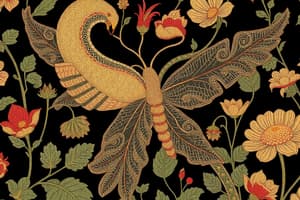Podcast
Questions and Answers
What is the primary role of microorganisms in sustainable ecosystems?
What is the primary role of microorganisms in sustainable ecosystems?
- To break down dead plants and animals into nutrients (correct)
- To hold the soil in place
- To provide food for animals
- To pollinate flowers
Which of the following human activities is NOT a major cause of biodiversity reduction?
Which of the following human activities is NOT a major cause of biodiversity reduction?
- Deforestation
- Over-hunting
- Water pollution
- Sustainable fishing practices (correct)
What is the main purpose of establishing country parks, marine parks, and wetland parks?
What is the main purpose of establishing country parks, marine parks, and wetland parks?
- To reduce noise pollution
- To promote sustainable agriculture
- To provide shelter for wildlife (correct)
- To support conservation programmes
Which of the following species is NOT an example of an endangered species?
Which of the following species is NOT an example of an endangered species?
What is the primary goal of conservation efforts?
What is the primary goal of conservation efforts?
Which of the following is an example of a sustainable resource management practice?
Which of the following is an example of a sustainable resource management practice?
What is the main purpose of classification in living things?
What is the main purpose of classification in living things?
Which of the following is a characteristic of invertebrates?
Which of the following is a characteristic of invertebrates?
What is the unique feature of reptiles?
What is the unique feature of reptiles?
Which of the following plants produce seeds?
Which of the following plants produce seeds?
What is the term for the special body features that help living things survive in their habitats?
What is the term for the special body features that help living things survive in their habitats?
Where can we find the greatest biodiversity?
Where can we find the greatest biodiversity?
What is the term for the existence of many kinds of living things?
What is the term for the existence of many kinds of living things?
What is the result of the loss of any one kind of living thing in an ecosystem?
What is the result of the loss of any one kind of living thing in an ecosystem?
Flashcards are hidden until you start studying
Study Notes
Classification of Living Things
- Classification helps identify and study living things systematically using a key based on key features
- Grouping living things by their characteristics, such as external features
Classifying Animals
- Vertebrates: have a backbone (e.g. snake)
- Invertebrates: do not have a backbone (e.g. snail, octopus)
Classifying Vertebrates
- Fish: have slimy scales, gills, and fins (e.g. mudskipper, seahorse)
- Amphibians: have moist skin, lay eggs in fresh water, and no scales (e.g. salamander)
- Birds: have beak, wings, and lay eggs (e.g. eagle)
- Reptiles: have hard dry scales, lay shelled eggs (e.g. turtle)
- Mammals: have hair, mammary glands, and give birth to live young (e.g. walrus)
Classifying Plants
- Seed plants: produce seeds (e.g. dandelion, fruits, pea)
- Seedless plants: do not produce seeds (e.g. fern, produce spores)
- Flowering plants: produce seeds, flowers, and fruits (e.g. cotton tree, Bauhinia, orange tree)
- Non-flowering plants: produce seeds, but no flowers or fruits (e.g. pine, produce pine cones only)
Living Things and Habitat
- Habitat: the natural environment where a living thing lives
- Adaptation: special body features that help living things survive in their habitats (e.g. color for camouflage)
Biodiversity
- Biodiversity: the existence of many kinds of living things
- Tropical rainforests and coral reefs have the greatest biodiversity
- Ecosystem: all living things in a habitat interact with each other and the environment
- Interdependence: all living things in an ecosystem rely on each other
Importance of Living Things
- Plants: provide food, shelter, oxygen, and hold soil
- Microorganisms: break down dead plants and animals, turn into nutrients, and allow plants to absorb
- Animals: keep soil fertile, provide food, feed on nectar, and spread pollen
Human Dependence on Living Things
- Humans rely on plants and animals for resources such as food, raw materials, and medicines
Reduction in Biodiversity
- Causes of reduction in biodiversity: human activities, leading to extinction of animals
- Examples of human activities: destruction of habitat, over-hunting, pollution
- Endangered species: kinds of living things that are in danger of becoming extinct (e.g. bluefin tuna, black-faced spoonbill, tiger)
Conservation
- Conservation: protecting the environment and biodiversity of the Earth
- Ways to conserve:
- Protecting wildlife and their habitats
- Supporting conservation programs
- Practicing the 3Rs principle (Reduce, Reuse, Recycle)
- Using resources in a sustainable way (e.g. sustainable fishing method)
Studying That Suits You
Use AI to generate personalized quizzes and flashcards to suit your learning preferences.




